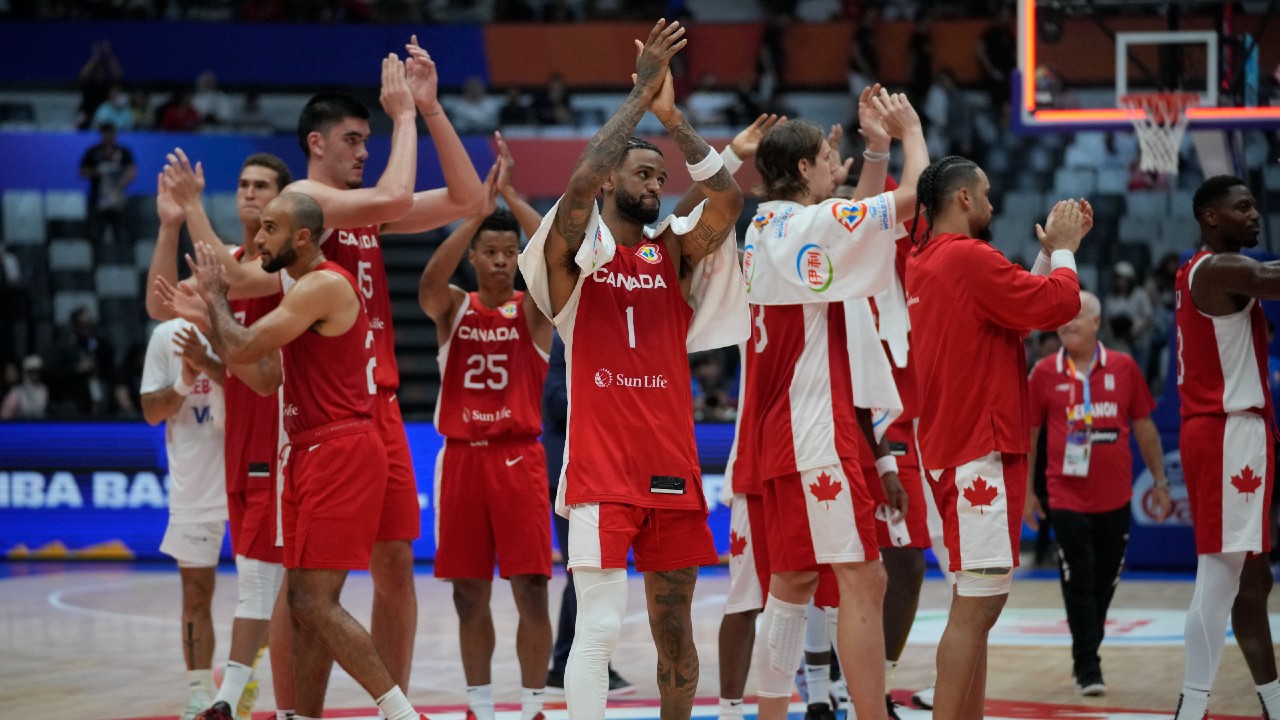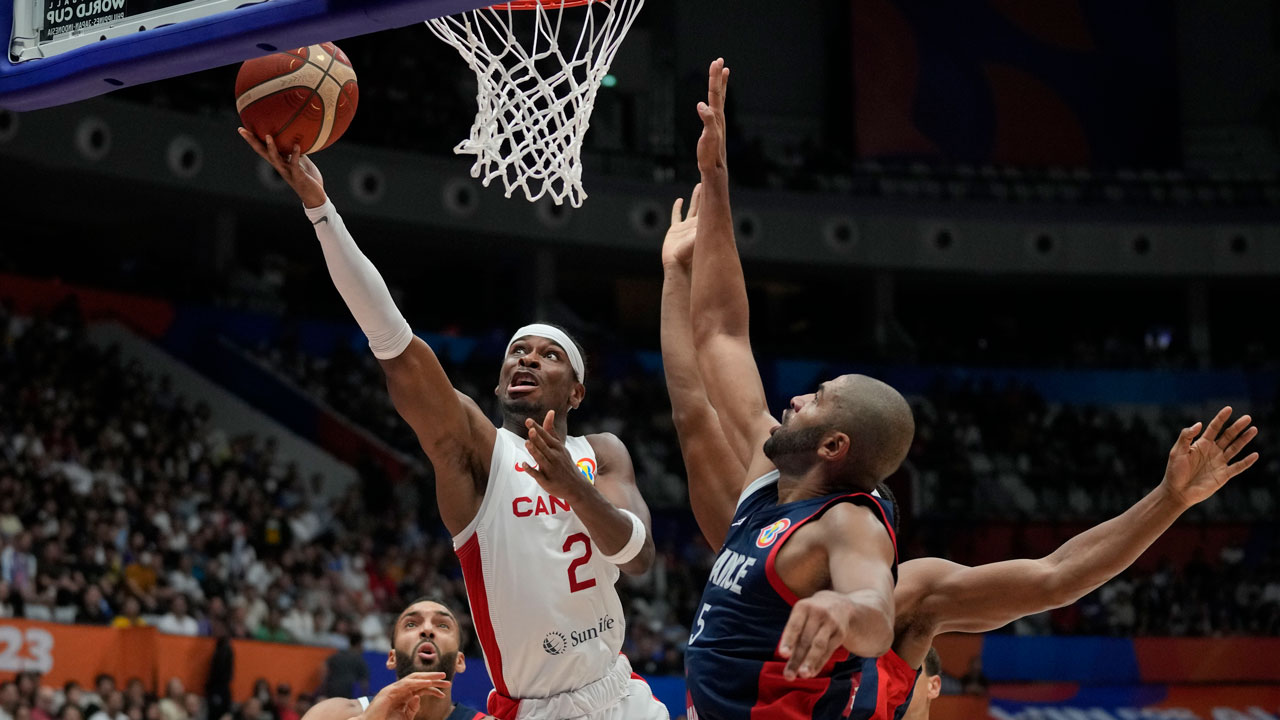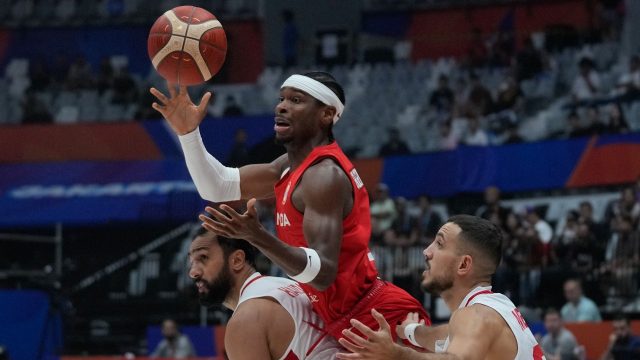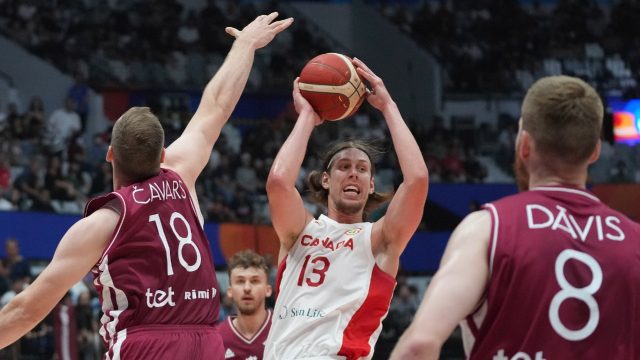
The first exhale feels incredible, for so long as it takes you to hold your breath once more.
Canada’s senior men’s basketball team overcame the first major hurdle this week at the FIBA World Cup, securing its place in the second round of the tournament with a perfect 3-0 finish.
On paper, that hurdle should have been modest, a championship-round-of-limbo height off the ground. In reality, the hurdle was balanced ever higher on 22 years of near-misses and failed promises from the program, leaving Canadian basketball fans too often to wonder when the second shoe would drop.
Shai Gilgeous-Alexander and company took all of one game to put past worries to bed. After a stop-and-start first half against France, Canada put its foot on the gas and through the floorboards, ultimately embarrassing a team with a top-five world ranking and top-five betting odds of winning the entire tournament.
That win alone was not all Canada had to accomplish, but it is the exact point at which so many other versions of this team have come up short — the first matchup with an actually elite team, the first understandable slip-up in a tough field, or, often, just an event-opening loss chalked up to lack of preparation.
Canada Basketball did everything it could to avoid the latter problem, investing in a longer ramp-up period and five high-end tune-up games before the action that counted in Jakarta, Indonesia.
This Canada team opened the tournament ready to play, a combination of emerging chemistry, the right levers pulled by head coach Jordi Fernandez, and — and this is really nice to say — the best player in its group, and arguably the entire tournament in Gilgeous-Alexander.
The bludgeoning of France rolled into a history-making blowout of Lebanon and concluded with a win over Latvia that was tough and tight until it decidedly wasn’t. All told, Canada leaves the first round with a plus-111 point differential, eclipsing every team in the event (including the United States, who had a noticeably lighter group).
A dominant first round does more than just punch Canada’s ticket for the second round, which begins Friday. It also creates an advantageous situation when it comes to advancing to the quarterfinals and, yes, eventually, perhaps the 2024 Paris Olympics.
More importantly, though, the strong start should assuage the worries that there’s still another shoe to drop with this team. The World Cup format leaves little room for error, and Canada has operated with a commensurate amount of doubt. There is a world of work still to do.
For now, Canadian basketball fans can allow themselves to release decades of tension. This team is for real, and the only reason fans should still be waiting with bated breath is because there is so much opportunity ahead.
Here’s a rundown of where things stand and what is to come:
How does the second round work?
Canada (3-0, plus-111) and Latvia (2-1, plus-15) were the two teams to advance from Group H. The two countries now form Group L with the two teams who advanced from Group G, Spain (3-0, plus-68) and Brazil (2-1, plus-35).
Records and point differential carry over from the first round, so Canada stands at the top of Group L right now.
From here, Canada will play Brazil (9:30 a.m./6:30 a.m. PT Friday on Sportsnet) and Spain (9:30 a.m./6:30 a.m. PT Sunday on Sportsnet). Latvia will play those teams as well, giving every team five games. The two teams with the best five-game record and point differential, across both rounds, will advance to the quarterfinals.
For Canada, two wins would push them through, and push them through as the top-ranked team from Group L. Two losses would likely eliminate Canada, unless some less-plausible scenarios took us to multi-team tiebreakers.
There are a few different scenarios if Canada splits the games, but beating Brazil puts them in a favourable spot. Regardless, the goal should be to sweep Group L for insulation against weird scenarios, and because these games carry heavy weight in future FIBA rankings (which feed into future seedings and groupings).
What might the quarterfinals look like?
If Canada makes the quarters, they would crossover with Group K. That group consists of Slovenia (3-0, plus-51), Germany (3-0, plus-47, which Canada split a pair of exhibition games with), Australia (2-1, plus-43) and Georgia (2-1, plus-15).
The first-place team from Group L plays the second-place team from Group K and vice versa. Based on the opening-round games, there’s not a strong lean in preference between Slovenia, Germany, and Australia, so the Canadians are better off finishing as the top seed in Group L and avoiding the best team in Group K.
Looking ahead to the semifinals, Canada could potentially play the United States because of how groups crossover. While I understand the idea of maybe wanting to avoid the U.S. as long as possible, this tournament requires you to just keep winning and let the opponents fall as they may. It’s simply too risky to look ahead to scenarios you may not get to if you don’t take care of every opponent. (And yes, the expectations are high here, but Canada has never even made a World Cup semifinal … let’s not get too cute. You’re cute enough, reader.)
Remind me how Canada qualifies for the Olympics, and what’s the progress on that?
In addition to being a big, fun, difficult and important tournament on its own, the World Cup is also the best path to qualifying for the 2024 Paris Olympics. To qualify, Canada will have to finish among the top two teams from the Americas region.
So, some bad news: Five of the seven Americas teams have advanced to the second round. That speaks to the quality of the zone Canada plays in, but it also muddies the Olympic waters a bit here in the second round.
Venezuela and Mexico have been eliminated.
The United States is in as good a spot as Canada, atop its second-round group at 3-0 and plus-103, with games to come against Lithuania and Montenegro.
The Dominican Republic (3-0, plus-19) is Canada’s biggest threat outside of the U.S., as it wound up in the easiest quadrant of the tournament and played very well in knocking off presumed group favourite Italy. The Dominicans are in a second-round group with Puerto Rico (and Serbia). While stranger things have happened, the Dominican Republic making the quarterfinals and Puerto Rico being eliminated here is the likely outcome.
Canada can control some of its own fate by beating Brazil on Friday. That would both give Canada a good chance at moving on and put Brazil up against the ropes.
As a procedural note, the teams that are eliminated in the second round are seeded 9-through-16 based on record and point differential through these five games. So, in a scenario where only the U.S. makes the quarters, the second Olympic qualifier would be based on that five-game result.
The U.S., Dominican Republic and Puerto Rico all crossover into the same quarterfinal matchups, while Canada and Brazil cross over with a group that has no other Americas teams.
Teams eliminated in the quarterfinals are seeded based on classification games (think of it like a consolation bracket). Making the quarters, then, is huge not just for advancing further than other Americas teams but also because it leaves you in more control of your ultimate finish in the tournament.
The knockout-stage games are played Sep. 5-10.
What should we be looking out for against Brazil and Spain?
I promise I’m not just staying loyal to my brand here: FIBA Bruno Caboclo is a problem. He had one of his worst recent FIBA games on Wednesday, but generally speaking, he’s been one of Brazil’s most impactful two-way players.
The FIBA rules and shorter space to cover to the three-point line really suit Caboclo’s defensive game and allow him to work as more of a rim-protector than the NBA game did. He’s also one of the best rebounders in the tournament.
Elsewhere, Brazil is a solid outside shooting team that hit 37 per cent of its threes in the first round and twice hit 14 in a game. The Brazilians also hit the offensive glass well, led by Caboclo.
Most of the offence, outside of second chances, will run through Yago Santos, one of the tournament’s leading playmakers and a real threat to pull up from the top of the arc. Marcelinho Huertas will also run some offence and look for Caboclo inside, while Cristiano Felicio is a familiar name offering some size inside.
Spain, meanwhile, looked a bit better in the first round than it did in its overtime exhibition loss to Canada, sharpening up some of the looser parts of its game from that tune-up. The Spanish are exceptionally well-coached by Sergio Scariolo, with enough offensive creativity and versatility to nudge Canada outside of its defensive comfort zone if things are clicking. (With that said, France also looked that way heading in.)
Willy Hernangomez has been a dominant scorer for Spain so far, flanked by Juancho Hernangomez and Santi Aldama for a trio of scoring punch with real size. Where Spain has dropped off some is in guard play compared to their golden era, as Sergio Llull has struggled and Juan Nunez, while very crafty, may have some trouble with Canada’s perimeter length. Still, it’s Spain, and there is enough institutional knowledge, chemistry and size-skill combinations here to be a very tough out for any opponent in this tournament.
What’s worked so well for Canada?
Gilgeous-Alexander has been arguably the best player in the tournament. Fernandez looks every bit as good a coach as we’ve been led to believe, clearly having picked up a lot in the Spain and Nigeria FIBA systems, as well as the NBA.
FIBA Kelly Olynyk is an absolute dream as an offensive hub who uses his guile and the greater physicality of the international game to be a presence on the other end. And Canada’s defence, while twice caught a bit flat-footed to start games, has the highest upside of any defensive unit in the World Cup. A lot has gone right, and that’s without Lu Dort for two of these games.
Any final thoughts?
From this point forward, there are no light spots in the schedule. There are no good matchups, just slightly better ones. The Canadians have shown everything we could have asked them to so far, but the tournament format allows little room for error. They will have to be as diligent with Brazil and Spain as they were in the second halves of the France and Latvia games, ideally for the full 40 minutes.
Enough caveats? Fine. There is also this: Canada looked better in the first round than arguably any team in the event, and there is ample room to play even better. They should be quarterfinals-bound for the first time since 1994.
And if they don’t get there? At least I’ll have finally, at long last, been proven right about Bruno.








